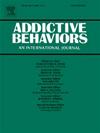Cannabis use regimens in trauma-exposed individuals: Associations with cannabis use quantity and frequency
IF 3.7
2区 医学
Q1 PSYCHOLOGY, CLINICAL
引用次数: 0
Abstract
People with trauma histories have an increased odds of cannabis use. Little is known about the frequency or consequences of different cannabis use regimens in cannabis users with trauma histories. Individuals with anxiety disorders tend to administer benzodiazepines in a pro re nata (PRN; i.e., as needed) as opposed to regularly scheduled (RS, e.g., twice daily [BID], three times daily [TID]) manner. Although physicians tend to prescribe benzodiazepines on a PRN regimen to minimize use, this regimen is paradoxically associated with greater use levels. Indeed, PRN administration regimens may increase use via negative reinforcement processes. We extended this older benzodiazepine literature to cannabis by examining regimen of cannabis use among 94 trauma-exposed cannabis users (mean age = 35.1 years; 52.1 % male; 23.4 % with cannabis prescription). Participants reported their initial and current cannabis use regimen (PRN vs. RS vs. both [‘PRN+’]) and their past month cannabis use frequency (use occasions in last month) and quantity (grams/use occasion). Consistent with patterns in benzodiazepine research, PRN (47.1 % of sample) and PRN+ (43.5 % of sample) were more common than RS regimens (9.4 % of sample). Also consistent with patterns seen with benzodiazepines, our sample moved toward PRN regimens from initial to current use: e.g., 100 % of initial RS users switched to a regimen that included PRN use. Consistent with predictions emerging from learning theory, PRN and PRN+ cannabis users reported significantly higher cannabis use frequencies compared to RS users (p’s < 0.01). Unexpectedly, there were no significant differences between cannabis use regimen groups for quantity of cannabis/occasion. While limited by their cross-sectional nature, with longitudinal replication, result may have implications for identifying cannabis use regimens that minimize frequency of use and thereby reduce risk for negative health outcomes.
受创伤者的大麻使用方案:与大麻使用数量和频率的关系。
有心理创伤史的人吸食大麻的几率会增加。对于有心理创伤史的大麻使用者使用不同大麻疗法的频率或后果,人们知之甚少。患有焦虑症的人倾向于根据需要(PRN;即按需)而非定期(RS,例如每日两次 [BID]、每日三次 [TID])服用苯二氮卓类药物。虽然医生倾向于按照 PRN 方案开具苯二氮卓类药物,以尽量减少用药量,但与之矛盾的是,这种方案的用药量却更大。事实上,PRN 给药方案可能会通过负强化过程增加用药量。我们通过研究 94 名受过创伤的大麻使用者(平均年龄 = 35.1 岁;52.1% 为男性;23.4% 有大麻处方)的大麻使用方案,将这一较早的苯二氮卓文献延伸到大麻领域。参与者报告了他们最初和当前使用大麻的方式(PRN vs. RS vs. 两者皆有['PRN+'])以及上个月使用大麻的频率(上个月使用次数)和数量(克/次)。与苯二氮卓研究的模式一致,PRN(占样本的 47.1%)和 PRN+(占样本的 43.5%)比 RS 方案(占样本的 9.4%)更常见。与苯二氮卓类药物的使用模式一致,我们的样本从最初使用到目前使用的过程中也逐渐转向 PRN 方案:例如,100% 的最初 RS 使用者转而使用包括 PRN 在内的方案。与学习理论的预测一致,PRN 和 PRN+ 大麻使用者报告的大麻使用频率明显高于 RS 使用者(P's
本文章由计算机程序翻译,如有差异,请以英文原文为准。
求助全文
约1分钟内获得全文
求助全文
来源期刊

Addictive behaviors
医学-药物滥用
CiteScore
8.40
自引率
4.50%
发文量
283
审稿时长
46 days
期刊介绍:
Addictive Behaviors is an international peer-reviewed journal publishing high quality human research on addictive behaviors and disorders since 1975. The journal accepts submissions of full-length papers and short communications on substance-related addictions such as the abuse of alcohol, drugs and nicotine, and behavioral addictions involving gambling and technology. We primarily publish behavioral and psychosocial research but our articles span the fields of psychology, sociology, psychiatry, epidemiology, social policy, medicine, pharmacology and neuroscience. While theoretical orientations are diverse, the emphasis of the journal is primarily empirical. That is, sound experimental design combined with valid, reliable assessment and evaluation procedures are a requisite for acceptance. However, innovative and empirically oriented case studies that might encourage new lines of inquiry are accepted as well. Studies that clearly contribute to current knowledge of etiology, prevention, social policy or treatment are given priority. Scholarly commentaries on topical issues, systematic reviews, and mini reviews are encouraged. We especially welcome multimedia papers that incorporate video or audio components to better display methodology or findings.
Studies can also be submitted to Addictive Behaviors? companion title, the open access journal Addictive Behaviors Reports, which has a particular interest in ''non-traditional'', innovative and empirically-oriented research such as negative/null data papers, replication studies, case reports on novel treatments, and cross-cultural research.
 求助内容:
求助内容: 应助结果提醒方式:
应助结果提醒方式:


